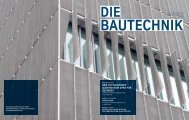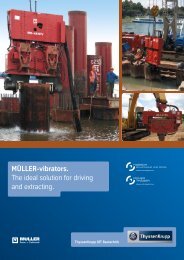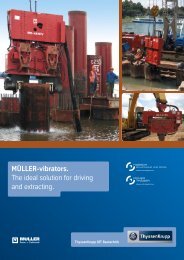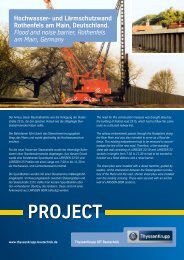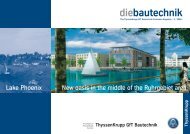NeW THYSSeNKRUPP QUaRTeR NOW OPeN FOR BUSINeSS
NeW THYSSeNKRUPP QUaRTeR NOW OPeN FOR BUSINeSS
NeW THYSSeNKRUPP QUaRTeR NOW OPeN FOR BUSINeSS
You also want an ePaper? Increase the reach of your titles
YUMPU automatically turns print PDFs into web optimized ePapers that Google loves.
06 geRMaNY LeaD STORY<br />
The external facilities are just as impressive as the architecture of the<br />
buildings. Some 700 trees, numerous landscaped areas and a pond<br />
200 m long by 30 m wide substantially improve the microclimate of<br />
the whole site. They are integral ingredients in the concept of a modern<br />
working environment.<br />
Demands for the sustainable use of raw material resources were met<br />
in the design and construction of the buildings and the grounds. The<br />
heat/cold in the ground will be used for geothermal heating and cool-<br />
ing, while heat will be recovered from the waste air from the offices.<br />
A newly developed sunshade system consisting of some 400 000<br />
centrally controlled slats will ensure pleasant indoor temperatures.<br />
The rainwater falling on the roofs of the ThyssenKrupp Quarter will<br />
be drained into the lake in the neighbouring Krupp Park. From there<br />
it will be fed into the River Emscher, where it will help to improve<br />
water quality.<br />
Dr. Ekkehard Schulz gives us an insight into the background: “The<br />
decision to relocate the Group’s head offices to Duisburg and Essen<br />
was and still is a sign of our firm commitment to Germany, North<br />
Rhine-Westphalia, and the Ruhr. For even as a globally active technology<br />
group, we remain a company of the Ruhr. This tradition is<br />
important to us, it shapes who we are and what we do – throughout<br />
the world.”<br />
THYSSENKRUPP QUARTER<br />
SETS NEW STANDARDS<br />
Sustainable treatment of environment and natural resources<br />
“The ThyssenKrupp Quarter is to become a symbol for the forwardlooking,<br />
sustainable development of the Group.” This ambitious aim,<br />
set out by ThyssenKrupp in the guidelines for the architectural competition,<br />
has now been successfully realised after a construction period<br />
of around three years. This is reflected in an efficient energy supply<br />
concept, the predominant use of materials available or produced<br />
locally, and an energy-efficient heating and cooling system for the<br />
buildings, to name just a few examples.<br />
This project set the direction for an urban development programme with<br />
significance beyond the region. Sustainable development must meet<br />
ecological, economical and social objectives – ecological in the sense<br />
of protecting health and the environment, economical with regard to the<br />
sparing use of resources, and social in terms of fair, integrative and<br />
pleasant living conditions.<br />
Office buildings as power plants<br />
The ThyssenKrupp Quarter will use the heat and cold stored in the<br />
ground for geothermal heating and cooling. To do this, ground couplings<br />
were installed at depths of up to 100 m in the roughly 1000 m²<br />
“geothermal field”. ThyssenKrupp GfT Bautechnik supplied the plant<br />
necessary for drilling the boreholes – a HBR 205 GT drilling rig. A total<br />
of 30 boreholes 100 m deep will in the future extract heat from deep in<br />
the ground for efficient space heating and hot-water supplies.<br />
The geothermal system not only heats and cools the buildings, it<br />
can also be used to store surplus heat or cold in the ground.<br />
Responsibility for the environment<br />
Before construction work started, the entire site of the Quarter was<br />
examined for possible legacies from almost 200 years of industrial<br />
history such as obstructions or contamination. With the assistance of<br />
experts, minor contamination was professionally disposed of off-site.<br />
The landscaping of the site is exemplary. More than 700 trees will be<br />
planted – involving 15 species from five continents. Throughout the<br />
Quarter, rainwater on the roofs of the buildings will be collected and<br />
fed to the lake in Krupp Park via a drainage system separate from the<br />
effluent drains. For this innovative rainwater separation system in the<br />
ThyssenKrupp Quarter, the Emschergenossenschaft water management<br />
association has presented ThyssenKrupp with its “Watermark”<br />
award. The “Watermark” from Emschergenossenschaft symbolises<br />
an intact natural water cycle and is awarded to projects making sustainable<br />
use of rainwater.<br />
eco-friendly construction materials<br />
In the construction of the ThyssenKrupp Quarter, only indigenous,<br />
fast-growing wood species were used whose production conditions<br />
are known. In the interiors too, e.g. wooden flooring, only eco-certified<br />
wood was used. The materials for the external areas were selected<br />
consciously on the basis of sustainability. In the majority of cases,<br />
materials produced locally or nationally from renewable sources were<br />
used.<br />
Lighting power consumption optimised<br />
To limit power requirements, the ThyssenKrupp Quarter will use a<br />
fully automated system with daylight-dependent brightness control<br />
and presence detection. That means light will only be provided where<br />
and to the extent to which it is really required. Lifts are fitted with LED<br />
lights, which in comparison with conventional fluorescent tubes use<br />
up to 90% less energy. And on the escalators as well, low-level LED<br />
strips and LED underglow lighting ensure the necessary level of<br />
brightness.<br />
award for sustainable building<br />
The ThyssenKrupp Quarter sets new standards for minimised consumption<br />
of energy and resources, the increased use of renewable<br />
resources, minimal ecological impact and the creation of modern<br />
working environments. At the EXPO REAL 2009 international real<br />
estate show, the German Sustainable Building Council (DGNB) awarded<br />
the new building a Pre-certificate in Gold for the newly created<br />
German Certification for Sustainable Buildings.<br />
Technology: ThyssenKrupp products in new headquarters<br />
Almost 50% of the materials used in the construction of the new<br />
headquarters were supplied by ThyssenKrupp itself. In addition, there<br />
are 20 high-tech lifts, three escalators and further passenger conveyors<br />
that were produced within the ThyssenKrupp Group.<br />
geRMaNY 07<br />
Technology:<br />
ThyssenKrupp producTs<br />
in new headquarTers<br />
The most conspicuous proof of the group’s materials technology competence<br />
is found in the sunshades on building Q1: 400 000 stainless<br />
steel slats control the amount of incoming light. Stainless steel grade<br />
4404 has been used, a highly corrosion-resistant alloy containing chromium,<br />
nickel and molybdenum and supplied by ThyssenKrupp Nirosta.<br />
Shaped by ThyssenKrupp Umformtechnik, these slats are key elements<br />
in a sunshading system that so far is unique. But the real highlight is<br />
that the system aligns itself automatically according to the altitude of<br />
the sun, in doing so excludes direct sunlight and at the same time redirects<br />
the incident light into the interior so that the offices are properly<br />
illuminated. To do this, the slats, each about 7 cm long, are fixed to<br />
vertical central shafts. These shafts can rotate and therefore align the<br />
stainless steel slats according to the altitude of the sun. Data concerning<br />
the respective seasonal trajectory of the sun are stored in the<br />
system’s control and additional information about the current weather<br />
situation is gathered by the system from a weather station on the roof<br />
of Q1. On cloudy days all the slats are rotated such that the sunshade<br />
remains open.<br />
More than 10 000 m² of steel flats with an innovative special coating<br />
were produced for the headquarters by ThyssenKrupp Steel Europe.<br />
The coating, sold under the trade name of PLADUR ZM Premium, has<br />
a high-quality appearance due to its multi-coat paint finish in a shade<br />
known as “pearl metallic gold Q1”.<br />
Thanks to this special pigment, the coloured tinge of the surfaces<br />
changes with the light or viewing angle. The coating was applied using<br />
the so-called coil coating method in which paint is applied to a flat ribbon<br />
of sheet steel in a continuous process in special plants. The principal<br />
technical innovation is that the surface of the sheet steel is protected<br />
by a zinc-magnesium alloy before the paint is applied. This alloy<br />
provides a level of corrosion resistance that is almost double that of<br />
conventional hot-dip galvanising.<br />
The fully automatic system for controlling the brightness in the<br />
individual rooms closes the slats in the windows of the buildings<br />
when the sunlight is too intense.



